Table of Contents
- Concentrate-middling routing
- A combination rating
- Primary
- Secondary
- Miami Copper Co. mill
- The Inspiration Consolidated Copper Co. mill
- Mountain Copper Company, No. 1 concentrator
- Consolidated Arizona Smelting Co. mill
- The Anaconda Copper Mining Company
- Daly-Judge Mill
- The Burro Mountain Concentrator
- Timber Butte Milling Company
- The West Mill No. 2 of the Bunker Hill and Sullivan Mining Company
- Summary
Typical flotation flowsheets may be classified into two general types on the basis of the part which flotation plays in the mill treatment scheme and each of these classes may be again sub-divided on the basis of the method of routing the pulp through the flotation machines. On the first basis, a flow-sheet is of the “primary” type when flotation is the primary or principal means of concentration employed and the bulk of the concentrate is recovered thereby. The flow-sheet is of the “secondary” type when flotation is an accessory or subordinate process and some other means of concentration, usually gravity concentration, is the principal method of treatment. On the basis of pulp routing, a flow-sheet is of the “concentrate-middling” type when the flotation feed pulp passes through a set of machines in series, and these machines deliver finished froth concentrate off the early cells, a clean tailing as the underflow or spigot product of the last cell; and a low-grade froth or middling as the over- flow of the later cells, this middling being returned to the head of the machine. A flow-sheet is of the “rougher-cleaner” type when two machines, not in series, comprise the flotation installation, and the first machine makes a finished tailing and a low-grade concentrate which latter is sent to a second machine for cleaning. The second machine makes a finished high-grade concentrate and an underflow or spigot product constituting a middling, which is returned to the first or rougher cell. Combinations of these two methods of routing are also met with and may be classed as “combination” methods. Figures 42, 43 and 44 present, in a general way, these three routings. It will be understood, of course, that many combination routings are possible, although most of them are of the general character shown. It will thus be seen that mill flow-sheets may be classified under six possible heads:
- primary, concentrate-middling routing;
- primary, rougher-cleaner routing;
- primary, combination routing;
- secondary, concentrate-middling routing;
- secondary, rougher- cleaner routing;
- secondary, combination routing.
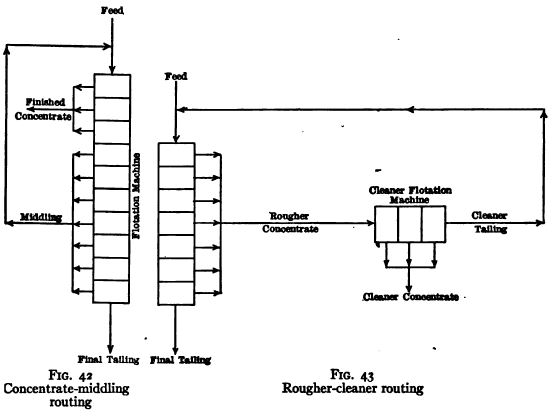
Concentrate-middling routing
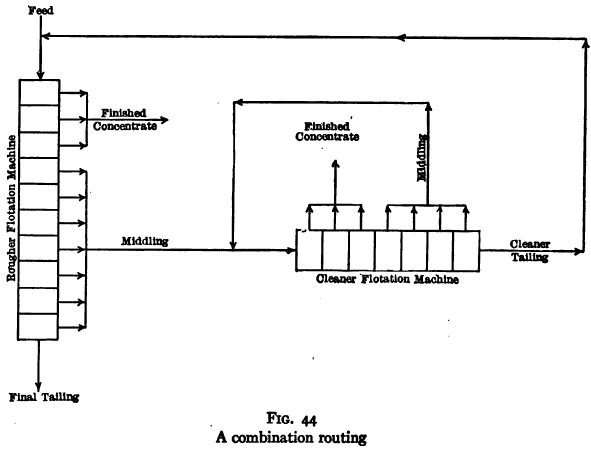
A combination rating
The bases for the differences in methods of flotation treatment are (1) the differences in the mode of occurrence of the valuable minerals in an ore and (2) the inability inherent in flotation processes to make a finished concentrate and a finished tailing with no material of intermediate value, in one treatment on one and the same machine. If the sulphide mineral in an ore occurs in coarse aggregates, a considerable proportion can be saved by gravity concentration at a less cost than by flotation, and ordinarily in the form of a concentrate that is more valuable than the concentrate made by flotation; assuming, of course, that the specific gravity of the gangue is sufficiently different from that of the sulphide to make gravity concentration efficient. In such case, flotation will probably form a subordinate part of the flow-sheet. On the other hand, if the sulphide mineral is disseminated through the ore in fine grains and the difference in specific gravity between the sulphide mineral and the gangue is not great, gravity concentration can recover only a small part of the valuable mineral and flotation should form the principal part of the treatment scheme. The choice as to the method of routing depends, to a large extent, on the percentage of floatable minerals present in the ore and on the grade of concentrate desired. A rougher-cleaner routing is usually used where the percentage of mineral in the flotation feed is low, and the concentrate-middling routing or combination routing is used when the percentage of mineral is high. The rougher-cleaner routing is best adapted to making a high-grade concentrate.
The following tabulation shows the character of the flow-sheets, on the basis of the classification presented, at representative concentrating plants. Several of them are given in detail on subsequent pages.
Primary
Rougher-cleaner routing.
Miami Copper Co: (copper).
Inspiration Copper Co. (copper).
Arizona Copper Co. (copper).
National Copper Co. (copper).
Concentrate-middling routing.
Mountain Copper Co. (copper).
Utah Leasing Co. (copper).
Combination routing.
Consolidated Arizona Smelting Co. (copper).
Anaconda Copper Mining Co., Zinc plant
Secondary
Rougher-cleaner routing:
Daly Judge Mining Co. (lead-zinc).
Burro Mountain Concentrator, Phelps, Dodge Corporation (copper).
Magma Copper Co., Copper-sulphide plant.
Magma Copper Co., Zinc plant.
Concentrate-middling routing.
Anaconda Copper Mining Co., Copper plant
Silver Peak Mill, N.S.W. (silver-lead).
Combination routing.
Timber Butte Mill (zinc).
Bunker Hill and Sullivan, West Mill No. 2 (lead)
Silver King Coalition (silver-lead).
Federal Lead Co., No. 4 mill (lead).
Miami Copper Co. mill
Miami Copper Co. mill, Miami, Ariz. This mill consists of six sections of variable flow-sheet. One type is shown in Fig. 45. The ore is chalcocite in a gangue of decomposed granite and schist. It contains approximately 1 ½ per cent. sulphide copper and from 0.2 to 0.3 per cent. carbonate copper. The capacity of a section is from 800 to 1000 tons per 24 hours. Pulp is fed to the flotation machines with a consistency of 20 to 25 per cent, solids. From 0.5 to 0.75 lb. per ton of an oil mixture consisting of 90 per cent, coal-tar oil and 10 per cent, steam-distilled pine oil, is usually added. The pulp is neutral or very slightly alkaline. A concentrate containing from 40 to 50 per cent, copper and a tailing containing from 0.1 to 0.15 per cent, sulphide copper is made.
The Inspiration Consolidated Copper Co. mill
The Inspiration Consolidated Copper Co. mill, at Miami, Ariz., is described by R. Gahl in Trans. A. I. M. E., Vol. LV, page 576. The mill employs both agitation-froth flotation and bubble-column notation, some of the sections being equipped with one type of machine and some with the other. The bulk of the concentration is done by pneumatic-type machines. Of these machines some of the sections employ the Callow type and some the Inspiration type. Flow- sheets of sections employing the two types of machines are given in Figs. 46 and 47. The ore is chalcocite with some oxides and carbonates of copper in a gangue of schist and decomposed granite. The rated capacity of a section is 800 tons per 24 hours. The pulp is fed at approximately 25 per cent. solids. The ore contains in the neighborhood of 1 per cent. sulphide copper and a recovery of approximately 90 per cent. is made. A mixture of 95 parts of coal tar and five parts of wood oil in a neutral pulp is used. Dr. Gahl gives the oil consumption (1916) at about 1 ½lb. per ton of ore. It is probable that it is less at the present time. The following construction data are given in Dr. Gahl’s paper. The compartments in the Inspiration rougher machines are 3 ft. by 3 ft. 4 in. and in the cleaner machines three ft. by three ft., giving a combined compartment area of 516 sq. ft. and a capacity per square foot, on the basis of 800 tons, of 1.55 tons per 24 hours. It is stated that 100 per cent. overload did not seriously affect the grade of the tailing. The area of porous bottom in one of these machines is 340 sq. ft. The air consumption per sq. ft. of porous bottom is 11.8 cu. ft. per minute at a pressure of 4 ½lb. per sq. in. at the blower. The power required to deliver this air is 2.63 K.W. hours per ton treated, on the 800-ton basis. On the same basis the following figures hold: 0.425 sq. ft. of porous surface per ton per 24 hours; 0.645 sq. ft. of flotation machine area per ton per 24 hours; 1.75 sq. ft. of floor space devoted to flotation per ton per 24 hours; 5.68 sq. ft. of floor space per ton per 24 hours in the concentrator prop- er, excluding coarse crushing; 13.3 sq. ft. of floor space per ton per 24 hours for concentrator proper and settling department.
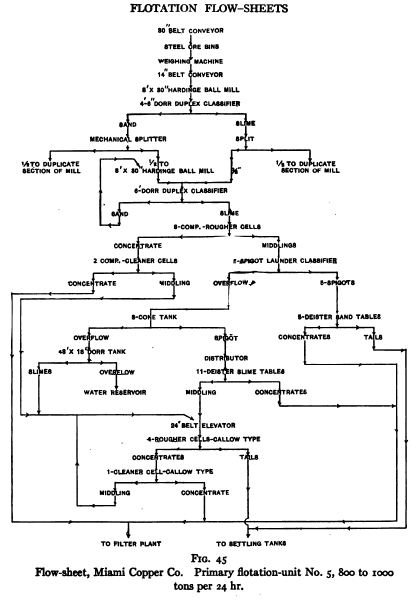
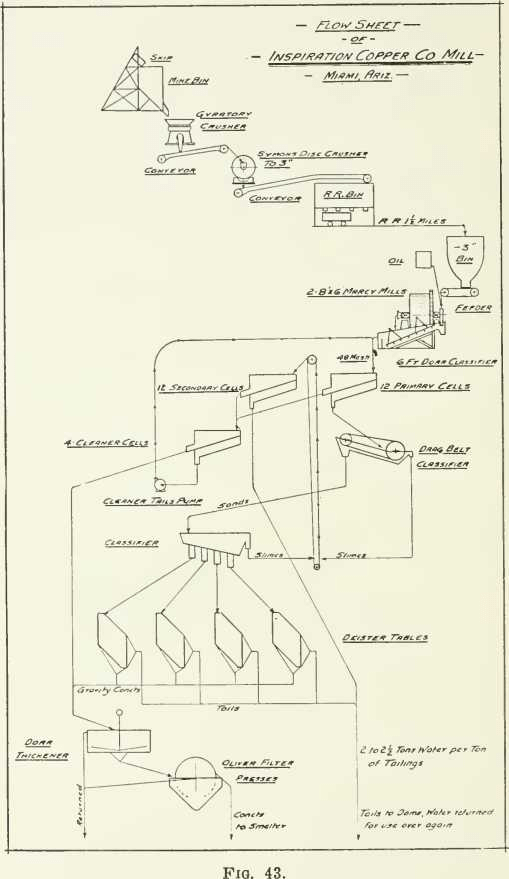
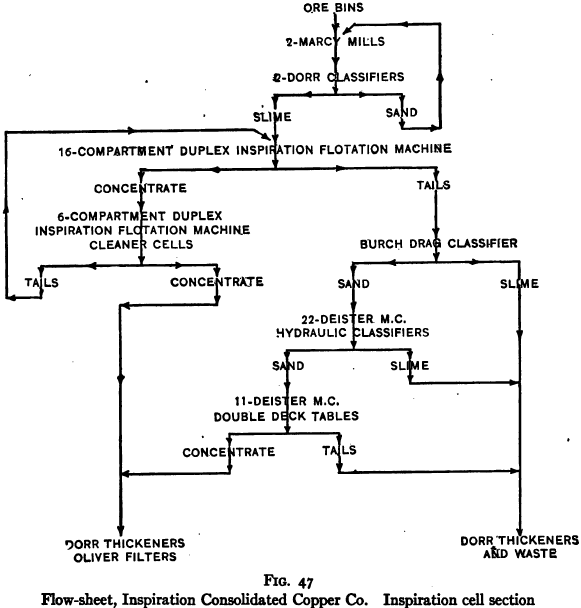
Mountain Copper Company, No. 1 concentrator
Mountain Copper Company, No. 1 concentrator at Minnesota Station, Shasta County, Cal., is described by L. C. White in Mining and Scientific Press, Sept. 6, 1919. The flow-sheet is shown in Fig. 48. The ore is chalcopyrite and pyrite in an alaskite-porphyry gangue. It carries 2 per cent. copper and 8 per cent. iron. The mill has a capacity of 550 tons per 24 hours, crushing to less than 4 per cent, on 60-mesh. The consistency of the pulp going into the flotation machines is about 30 per cent, solids. The oil mixture consists of 50 parts kerosene acid sludge and 50 parts of a mixture of crude turpentine, tar oil, and light fuel oil. Eight-tenths of a pound per ton of this mixture is fed to the grinding mills. A concentrate containing 15 per cent, copper is made with an average recovery of 92 per cent. and a 7:1 ratio of concentration.
Consolidated Arizona Smelting Co. mill
Consolidated Arizona Smelting Co. mill, at Humboldt, Ariz., is described by G. M. Colvocoresses in Engineering and Mining Journal, July 14, 1917. The flow-sheet is shown in Fig. 49. The ore consists of chalcopyrite and pyrite in schist and carries 3.2 per cent, copper and 15 per cent. iron. The flotation feed carries about 2 per cent, copper. Flotation concentrates assay 15 per cent, copper, 25 per cent, iron, and 20 per cent, insoluble. The roughing-table concentrate carries about 4 1/2 per cent. copper and 38 per cent. iron. Flotation and table concentrate mixed, forming the mill concentrate, assay 9 per cent. copper, 30 per cent. iron and 16 per cent. insoluble. Flotation tailing assays about 0.4 per cent, copper. The recovery by flotation is about 82 per cent. The capacity of the plant as shown is approximately 400 tons per 24 hours. The oil mixture consists of 70.4 parts of Standard Oil Company stove oil, 27 plus; 24.9 parts of refined wood creosote; and 4.7 parts Standard Oil Company Calol fuel oil, 24 plus. The average consumption of this mixture is 1.31 lb. per ton.
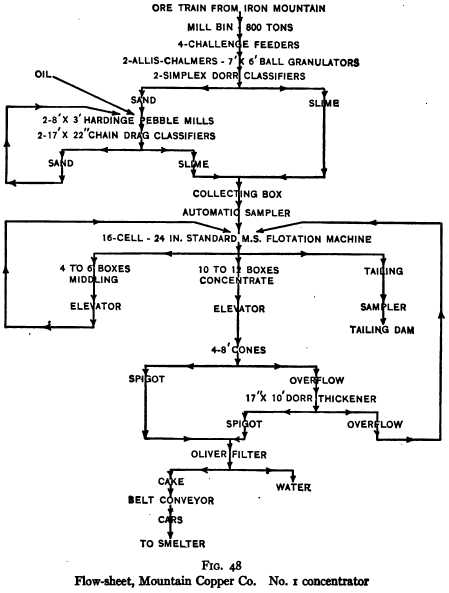
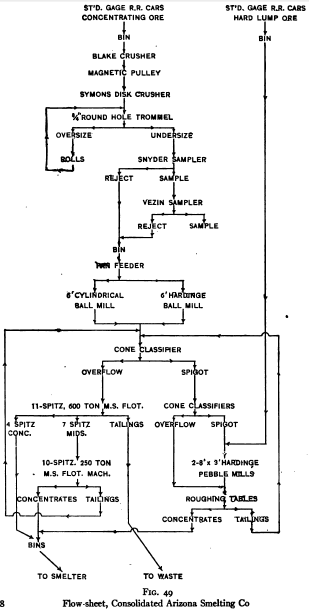

The Anaconda Copper Mining Company
The Anaconda Copper Mining Company operates one concentrator for the treatment of copper sulphide ores and another for the treatment of zinc sulphide ores. The flow-sheets of the two plants are given in Figs. 50 and 51 respectively, as represented by A. E. Wiggin in the trial of the case of Minerals Separation, Ltd. vs. Butte and Superior Mining Company, in the district court of Montana. The copper ore carries about 2.9 per cent, copper and considerable pyrite. Concentrates carry 8 per cent, copper, 21 per cent, iron and 28 per cent, soluble. The recovery in 1916 for the whole mill was 95.45 per cent, and the recovery for flotation about 94 per cent. In the sand-plant flotation, the oil mixture consisted of 3 to 3 1/2 lb. per ton of kerosene sludge acid and about 0.3 lb. per ton of hardwood creosote. From 6 to 8 lb. per ton of sulphuric add was also added. In the slime plant there was added from 3 to 3 1/2 lb. of kerosene sludge acid, 2 1/2 to 3 lb. wood creosote, and 15 lb. of sulphuric acid per ton of ore. The capacity of the plant is shown by numerals on the flow-sheet.
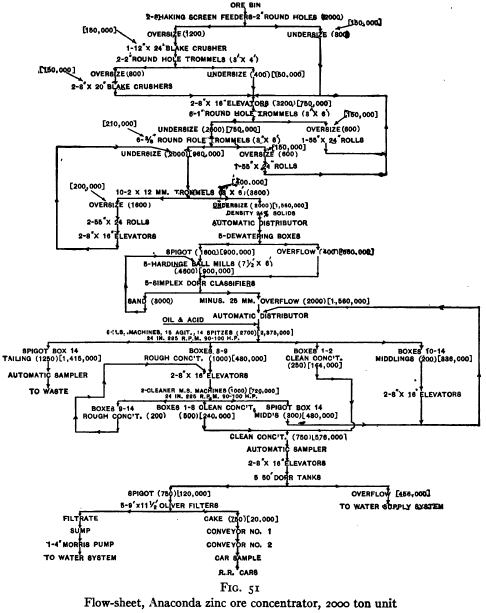
Note:—Figures in parenthesis show tons of solids per 24 hours. Figures in brackets show gallons of water per 24 hours.
| Density Per Cent Solids | Per Cent |
| Pulp from Crusher Section | 24 |
| Total Feed to Hardinge Mills | 55 |
| Original Feed to Flotation | 24 |
| Total Feed to Flotation | 22 |
| Total Concentrate | 25 |
| Feed to Oliver Filters | 61 |
| Filter Cake | 90 |
The feed to the zinc concentrator carried 13.3 per cent. zinc and a concentrate containing 33 per cent. zinc with a recovery of 92.8 per cent. was reported. This extremely low-grade zinc concentrate is allowable for the reason that it is treated electrolytically to recover the zinc, rather than by ordinary zinc- smelting methods. The oil mixture used consisted of 0.7 lb. per ton of kerosene sludge add and 2.7 lb. per ton of wood creosote. Sulphuric acid to the amount of 22.7 lb. per ton was also used. Tonnage and pulp-density figures are given on the flow-sheet.
Daly-Judge Mill
Daly-Judge Mill, Park City, Utah, is described by A. B. Parsons in the Salt Lake Mining Review, February 29, 1916. The flow-sheet is given in Fig. 52. Feed to the mill is a zinc-lead ore carrying 6 per cent, zinc, 3 1/2 per cent, lead and 5 per cent, silver. The flotation concentrate is separated on tables into a zinc concentrate carrying 48 per cent, zinc, 6 per cent, lead, 4 per cent. iron, 25 oz. silver and 3 1/2 per cent, silica; and a lead-iron concentrate carrying 42 per cent. lead, 7 per cent. zinc, 16 per cent, iron, 35 oz. silver and 1 1/2 per cent, silica. The oil used is a wood creosote. The capacity of the plant is given as approximately 50 tons per 24 hours. It would look from the flow-sheet as though the actual capacity would be considerably above this rated figure, especially in so far as the flotation equipment is concerned.
The Burro Mountain Concentrator
The Burro Mountain Concentrator of the Phelps, Dodge Corporation is described by F. C. Blickensderfer in the Engineering and Mining Journal, July 14, 1917. He gives the flow-sheet shown in Fig. 53. The ore assays about 1.9 per cent, copper of which 0.2 per cent, is carbonate and oxide and the balance chalcocite. The gangue is porphyry. A recovery of approximately 77 per cent, on the sulphides is reported in Mr. Blickensderfer’s paper. The flotation machines are of the Kraut and Kollberg type and are fed at the rate of 75 tons per 24 hours in a pulp containing 20 per cent, solids. Oil to the amount of 2.75 lb. per ton of ore is added at the points shown. Lime is added at the crushing machines to protect the iron work from attack by soluble salts. The ore coming from one part of the mine requires the addition of about eight pounds of sulphuric acid per ton at the flotation machines. The other ores are treated with lime as the only inorganic agent present.
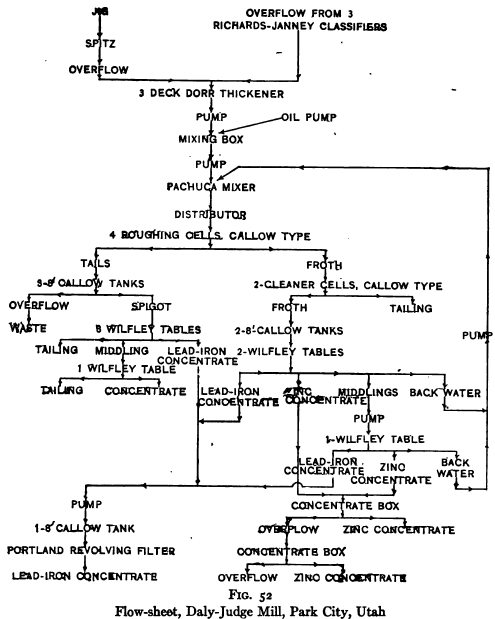
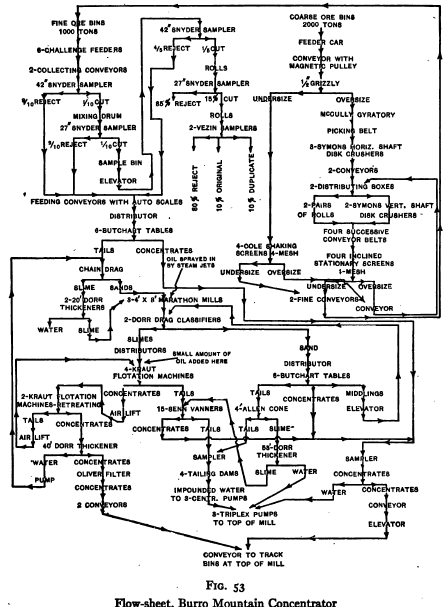
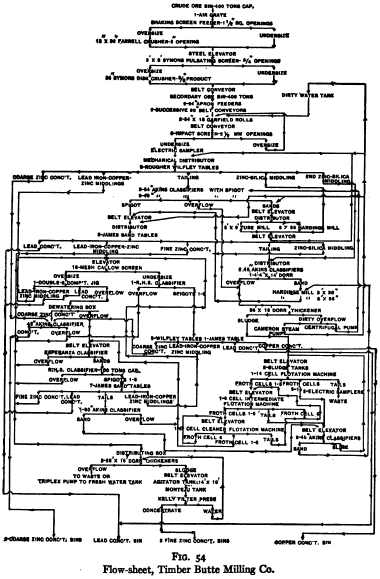
Timber Butte Milling Company
Timber Butte Milling Company, Butte, Montana. The operations at this mill were described by W. N. Rossberg in the trial of the suit of Minerals Separation, Ltd., vs. Butte and Superior Mining Company, in the district court of Montana, and the flow-sheet shown in Fig. 54 was presented by Mr. Rossberg. The capacity of the plant as shown is 450 to 550 tons per 24 hours. The ore consists of sphalerite and galena in a granitic gangue. The metallurgical results for the years 1915, 1916 and part of 1917 are given in Table XII. Tables XIII and XIV are of interest as showing the changes in oil and acid feed which are characteristic of much flotation practice. It should be borne in mind in reading the statements as to character of oil and oil consumption in connection with the other flow-sheets herein given and those published in the technical journals, that some such situation as is presented here undoubtedly has existed in most of the other plants and that the statements as to kind and quantity of oil used represent only the most common practice or the practice which happened to obtain at the time the article was written. Tables XIII and XIV illustrate clearly the statement made in another part of this book, that the slogan of “a different oil for every ore” which has been the rallying cry of some so-called flotation experts, needs considerable revision.

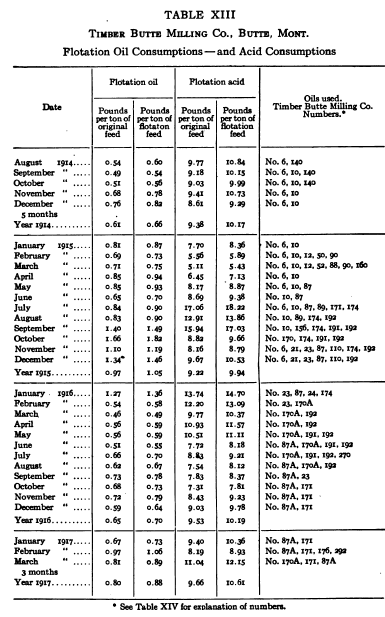
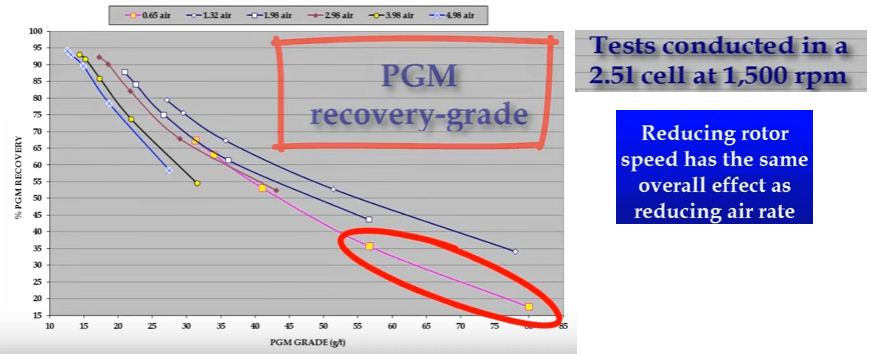
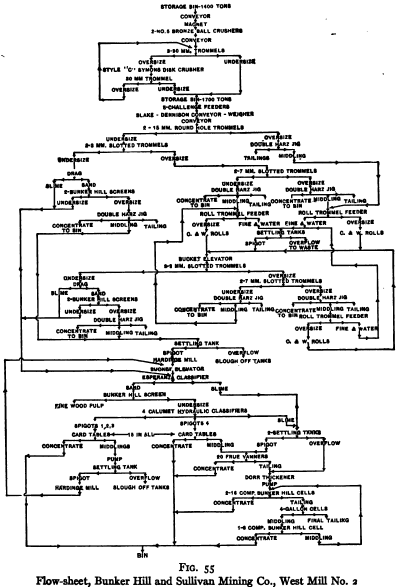
The West Mill No. 2 of the Bunker Hill and Sullivan Mining Company
The West Mill No. 2 of the Bunker Hill and Sullivan Mining Company is described by T. A. Rickard in Mining and Scientific Press, April 10, 1920. The flow-sheet is given in Fig. 55. The ore carries about 10 per cent, lead in the form of galena, some 2 per cent, zinc in the form of sphalerite, and three to four ounces of silver, in a gangue consisting principally of siderite and quartz. The feed to the flotation machines is at the rate of 95 tons per 24 hours in a pulp containing, after dilution by the return middling, 25 per cent, solids. Pine oil at the rate of 0.08 lb. per ton is used. The concentrate taken off the first flotation machine assays 60 to 65 per cent, lead and the tailing of this machine assays 3 1/2 to 4 per cent. lead. The concentrate from the Callow cells assays 30 per cent. lead and the tailing 1 per cent. lead. The concentrate from the final eight- cell cleaner assays 45 per cent. lead.
Summary
It will be noted that the flow-sheets of the copper mills are, in general, of the primary type. A majority of them employ the rougher-cleaner routing. The flow-sheets of the lead and zinc plants, on the other hand, are generally of the secondary type. A majority of them employ the concentrate- middling or combination routing. Departures from the general routing tendencies are, in many cases, due to causes not apparent on the surface. The Anaconda Copper Co., Copper Plant, is of the concentrate-middling type for the reason that Anaconda smelting operations are built upon the expectation of a concentrate containing a fairly high proportion of iron plus silica, and the relatively low-grade copper concentrate produced by the concentrate-middling routing is, therefore, satisfactory. This same concentrate at the International Smelter at Miami would be wholly uneconomical, and a change to the rougher- cleaner method of routing would undoubtedly be made if the concentrates were to be disposed of to this smelter or another with similar copper requirements. Flotation is a relatively new process and has been tacked on to existing processes in many mills, in which cases structural limitations have sometimes resulted in flow-sheets which depart from the general tendency. Finally, in some cases, caprice and prejudice have played a large part in the installation of flowsheets which differ widely and unwisely from the general principles set down.
Results to be expected in concentration by flotation depend largely upon the ore. The recovery to be expected increases with increase in the grade of heads and decrease in the grade of concentrate required. With a copper ore containing from 1 to 2 per cent, copper in the form of sulphide, and no carbonates, a recovery of 85 to 90 or even 95 per cent, may be expected with a concentrate containing not over 20 per cent, insoluble. On a 5 per cent, copper ore of the same variety the recovery should run over 95 per cent. When oxidized copper minerals are present they may be expected to distribute themselves between concentrate and tailing in about the proportions of the ratio of concentration. With lead ores or with zinc ores similar results may be expected, although it is usually not economical to push recovery to the same point as is sought in copper plants. When the feed contains mixed sulphides, the grade of concentrate will be lowered. Where differential flotation is practiced, as is commonly the case with lead-zinc ores and less frequently the case with ores containing copper and iron sulphides, each concentrate will be considerably contaminated with the sulphides sought to be placed in the other concentrate. With lead-zinc ores the lead concentrate ordinarily contains from 40 to 50 per cent, lead and from 8 to say 15 per cent, of zinc and the zinc concentrate from 35 to 50 per cent, zinc and from say 6 to 15 per cent, of lead. Somewhat better results can be obtained by the Horwood process, but whether at a cost which justifies the better grade of products is a matter for individual decision. Separation of copper sulphide from iron sulphide has not been practiced sufficiently to allow any general figures to be set up.
Flotation Flow-sheets P 199-227
